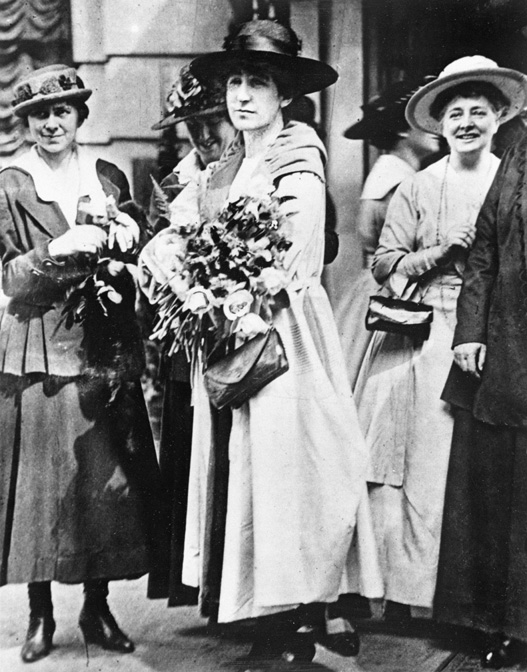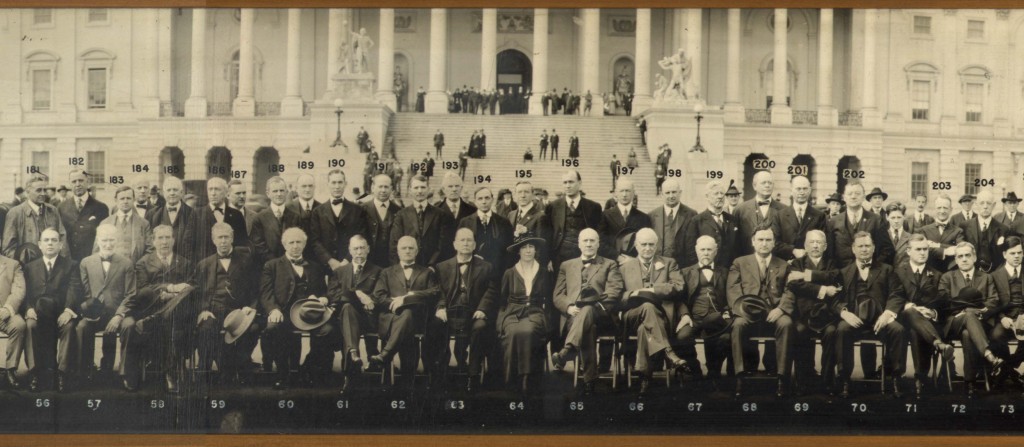
Jeannette Rankin of Missoula, Montana, was the first woman elected to the U.S. House of Representatives. Unsurprisingly, her election made headlines across the country. People wanted to know who this western upstart was and what this radical change might portend. The Kentucky Courier-Journal captured the magnitude of the political quake when it wondered, “Breathes there a man with heart so brave that he would want to become one of a deliberate body made up of 434 women and himself?”
Born on a ranch near Missoula in 1880, Jeannette Rankin was the oldest of John Rankin and Olive Pickering Rankin’s seven children. She attended the University of Montana, and in 1908—inspired by the career of Jane Addams, founder of Hull House, the famed Chicago settlement house—she headed to New York to study social work at the New York School of Philanthropy. She worked briefly as a social worker and then as an organizer for the National American Woman Suffrage Association in several states’ suffrage campaigns. In 1914 Rankin returned to Montana to help lead her state’s suffrage movement to victory. Rankin believed that western conditions, in which men and women had to share the tasks of settlement, encouraged greater gender equality than existed in the East, making it easier to convince Montana men to give women the vote.
Building on the grassroots organization she had created in 1914, she ran for Congress as a Progressive Republican in 1916 and won the seat. When she learned that she had been elected, she said, “I knew the women would stand by me.” And indeed, newly enfranchised Montana women went to great lengths to vote for her. Edith Mutchler wrote to Rankin from Chester to tell her that she was eight months pregnant when she “rode 14 mi on a cold windy day” to cast her ballot, but testified that she “would gladly do it again.”
Rankin’s first vote in Congress was on the highly charged issue of whether the United States should enter World War I. Rankin did not respond to the first roll call; on the second, she rose from her seat and stated, “I want to stand by my country, but I cannot vote for war.” While many women and men across the country supported her, others declared that her action proved that women did not have the constitution for politics. Such critics conveniently ignored the fifty-five male members of Congress who also voted against war. Rankin’s fellow freshman legislator, Fiorello La Guardia, recalled that, when asked if Miss Rankin was crying when she voted, he replied that he could not say, for he had not been able to see through the tears in his own eyes.

During the congressional term, Rankin pursued an agenda of progressive reform. She introduced a bill that protected American women from having their citizenship revoked when they married foreign men. She also supported legislation that sought to provide for maternal and infant health care. While neither of those measures passed, she was able to facilitate improved working conditions for women in the Bureau of Printing and Engraving. Rankin also used her position to publicize the grievances of Montana miners and farmers. In 1917 she attempted to mediate a bitter dispute between Butte copper miners and the Anaconda Copper Mining Company. The company proved resistant, even more so after she called upon the government to nationalize metal mines essential to the war.
Defeated in a bid for the Senate in 1918, Rankin spent the next twenty-two years working for peace organizations, such as the Women’s International League for Peace and Freedom, the Women’s Peace Union, and the National Council for the Prevention of War. She also created a second home near Athens, Georgia, where she strove to live a simple, self-reliant life and became an active grassroots organizer for the Georgia Peace Society. In 1940, at age sixty, she once again won election as a Republican from Montana to the U.S. House of Representatives. She became the only person in history to vote against U.S. entry into both world wars, but this time she voted alone.
Undaunted by public hostility, Rankin continued to work for peace in semiretirement. She traveled extensively, making several trips to India. Mahatma Gandhi was assassinated before she was able to meet him, but she believed his theories promised a model for world peace. With the onset of the Vietnam War, Rankin once again entered the political arena. In l968 she led several thousand women, the Jeannette Rankin Brigade, in a march on Washington, D.C., to protest U.S. involvement in yet another war. Rankin continued an active life of public speaking until her death at age ninety-three in 1973.
Historian Joan Hoff has summed up Rankin’s politics in this way: “[S]he consistently pursued a progressive brand of foreign policy that has its roots in Jeffersonian agrarian values, in a nonconsumer oriented life style, in direct, decentralized government, in reform at home before reform of the world, and finally, in the belief that people, especially women, could be educated in the habits of peace.”
In 1983, the Montana legislature chose to honor Jeannette Rankin by having her statue placed in the U.S. Capitol’s Statuary Hall, where each state may place statues of two individuals notable in that state’s history. Rankin’s statue joined that of Charlie Russell, making Montana the only state to be represented by an artist and a feminist. MM
Want to learn more? Read Joan Hoff Wilson’s articles, “‘Peace Is a Woman’s Job . . .’ Jeannette Rankin and American Foreign Policy: The Origins of Her Pacifism” and “‘Peace Is a Woman’s Job . . .’ Jeannette Rankin and American Foreign Policy: Her Lifework as a Pacifist,” both published in 1980 in Montana The Magazine of Western History. You can find links to the full text of all Montana The Magazine of Western History articles relating to women’s history here.
Sources
Giles, Kevin S. Flight of the Dove: The Story of Jeannette Rankin. Beaverton, OR: Lochsa Experience Publishers, 1980.
Hardaway, Roger D. “Jeannette Rankin: The Early Years.” North Dakota Quarterly 48, no.1 (Winter 1980), 62-68.
Harris, Ted C. “Jeannette Rankin in Georgia.” Georgia Historical Quarterly 58, no.1 (March 1974), 55-78.
Jeannette Rankin Papers, 1916-1919. Montana Historical Society Archives, Helena.
Josephson, Hannah. Jeannette Rankin, First Lady in Congress: A Biography. Indianapolis: Bobbs-Merrill, 1974.
La Guardia, Fiorello H. The Making of an Insurgent. New York: Lippincott, 1948.
Lopach, James J., and Jean A. Luckowski, Jeannette Rankin: A Political Woman. Boulder: University Press of Colorado, 2005.
Shirley, Gayle C. More than Petticoats: Remarkable Montana Women. Helena: Falcon Press, 1995.
Wilson, Joan Hoff. “‘Peace is a Woman’s Job . . .’ Jeannette Rankin and American Foreign Policy: The Origins of Her Pacifism.” Montana The Magazine of Western History 30, no.1 (January 1980), 28-41.
I am working on putting together a seminar on Jeannette Rankin for the Lifelong Learning Institute (an affiliate of Road Scholar) at Waubonsee Community College in Sugar Grove, Illinois. The audience is comprised of people 50 years and older. Any suggestions for materials would be appreciated.
You might want to look in our bibliographies as well as the list of articles published in Montana The Magazine of Western History, since those are available to download. Joan Hoff Wilson’s are very good. https://montanawomenshistory.org/research/bibliographies/
Thank you!!
I have my great grandmother Nora Jane Harris, Ball, Long, Dyson Diaries. In one of the almost 50 years it is mentioned that Jeannette stay with her for a week … The Rankin’s Place is mentioned many times as Ole Blue was either used there or would wonder there… Ole Blue was the horse I am sure. So I assume that Jeannette lived nearby or had family nearby? Great grandmother was important to a key…. she was born in Arkansa her mother’s grandfather was the late Jay Whittington Freeman important man in Indian affairs…. oh I have more on my lines to work with… in History of AMERICA